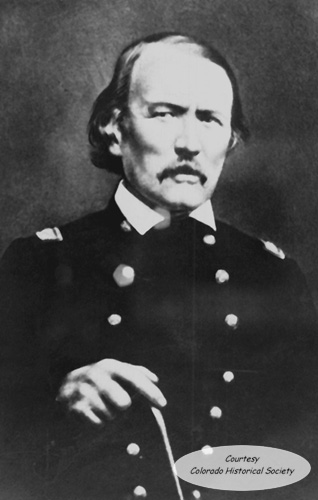 As was the custom the Kiowas and Comanches made their winter camp in Palo Duro Canyon. Their camps stretched
along what we today call Kit Carson creek near Bent's old post of Adobe Walls, in the Panhandle of Texas.
As was the custom the Kiowas and Comanches made their winter camp in Palo Duro Canyon. Their camps stretched
along what we today call Kit Carson creek near Bent's old post of Adobe Walls, in the Panhandle of Texas. Colonel Christopher (Kit) Carson's plan on November 3, 1864 was to trap and attack the hostiles while they settled into their familiar surroundings. With 300 cavalrymen and a compliment of one-hundred Utes and Jicarilla Apaches Colonel Carson and his men were ready and primed for to do battle as they left Cimarron, New Mexico in the hard cold of the winter. Making their way, at times through up to two feet of snow they found their quary on 26th of November.
The initial strike began at the upper part of the village, where the elderly and sick who, unfortunatley happened to be in residence, were killed. The camp was also destroyed. The second phase of the attack was to destroy the camp village.
Unbeknown to To-hauson, great chief of the Kiowas-at that time, Lieutenant Pettis' platoon of mountain howitzers accompanied Colonel Carsons' force. Chief To-hauson fought his way to the other encampments and warned of the impending attack. The women and childern fled. A white captive, Millie Durgan, was held in the brush until she was rescued by soldiers.
Chief To-hauson and hundreds of warriors forced Colonel Carson and his men to retreat under the deadly protection of Lieutenant Pettis' platoon of mountain howitzers. Had it not been for Pettis' mountain howitzers, Colonel Carson and his men would have been massacred.
The day belonged to the Indian warriors. Chief To-hauson proved his bravery even though his horse was shot from under him. Stumbling Bear carried his daughters' shawl for good luck. It was shoot up, with no harm done to Stumbling Bear.
In their retreat, the soldiers were harrassed in close quarters. Fires were set by the warriors so smoke could cover their position and their repeated charges against the soldiers.
Colonel John Chivington, who advocated Indian extermination, left Fort Lyon on November 29, to attack Black Kettle, the Cheyennes, and a small number of Arapahos who were with them. The Chivington massacre at Sand Creek, greatly increased the hostility of the Cheyennes and Arapahoes toward the whites. In 1868, General Sheridan's campaign against the Cheyennes and Arapahoes forced them to reside on a reservation. The result was the establishment of Fort Sill.
Source:
From the book "Carbine & Lance, The Story of Old Fort Sill",
by Colonel W. S. Nye, Norman, University Oklahoma Press. 1958
Colonel Christopher (Kit) Carson and the Navajo's infamous "Long Walk"
U.S. Representative Tom Udall (D-NM)-Commemorating the "Long Walk"
TESTIMONY OF THE NAVAJO NATION ON THE PROPOSED H.R. 1384 BILL TO AMEND THE NATIONAL TRAIL SYSTEM ACT TO DESIGNATE THE NAVAJO LONG WALK TO BOSQUE REDONDO AS A NATIONAL HISTORIC TRAIL
H.R.1384 Text, PDF: The text of the Bill is not available at this time.
Sponsor: Rep Udall, Tom(introduced 4/3/2001)
Latest Major Action: 8/21/2002 Became Public Law No: 107-214.
Title: To amend the National Trails System Act to designate the route in Arizona and New Mexico which the Navajo and Mescalero Apache Indian tribes were forced to walk in 1863 and 1864, for study for potential addition to the National Trails System.
Thirty-eight Congressional Record articles from the 107th Congress ranked by relevance on"#OR ( #1(H.R. 1384) #1(H. R. 1384).
http://thomas.loc.gov/cgi-bin/query/r?r107:@OR+(+@1(H.R.+1384)++@1(H.+R.+1384)++)